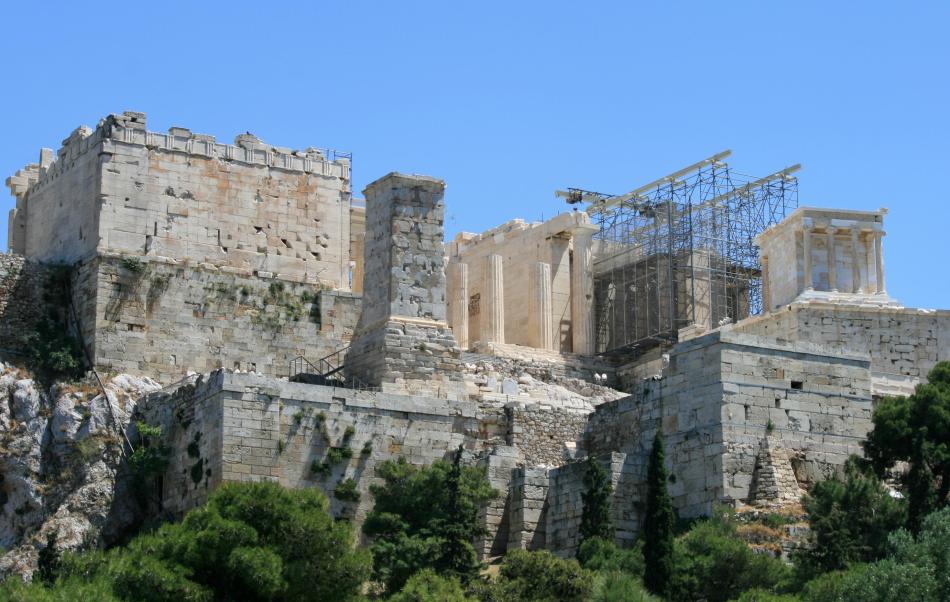We arrived in Athens one month ago and I’m finally getting around to writing about our very short visit. Athens was a quick stopover before our main event, Santorini. We stayed in Athens for two nights, giving us one full day for sightseeing. This was not enough time to experience the city – don’t make this same mistake.
Additionally, our one sightseeing day happened to fall on May Day. May Day is a national holiday in Greece and is one of five days during the year when all tourist sites and museums are closed.
It was safe to say that we had already lost our sightseeing battle with Athens before we arrived.
With the tourist sites closed, we did our best to see as much of Athens as possible. We spent the day traversing the city on foot and on the Metro and getting as close to a few of the major sites as possible.
Acropolis of Athens
The biggest letdown of our visit to Athens was that we were not able to visit the Acropolis. It was visible from almost everywhere we went, yet just out of our reach.

The Acropolis of Athens is a citadel situated on a rocky outcrop rising above the city of Athens. The top of the outcrop has a flattish area of about 7.3 acres.

The site contains many buildings, each in varying states of decay, destruction, and restoration. The site’s most important buildings include the Parthenon, the Propylaea, the Erechtheion, and the Temple of Athena Nike.

Arch of Hadrian
The Arch of Hadrian (also known as Hadrian’s Gate) at one time spanned an ancient Greek road. The road went from the center of Athens to the eastern side of Athens where several other notable structures were located (i.e. Temple of Zeus).

The arch is made from solid marble which was surprising because the stone did not look like marble, as in its traditional sense of shiny white stone with gray veins. The structure was built without cement or any type of mortar. Instead, clamps connect the stones. It’s 18 m / 59 ft tall and 13.5 m / 44 ft wide. It’s fully symmetrical from front to back and side to side.
The interior of the arch is 6.5 m /21 ft wide. It’s definitely wide enough for a modern car to drive through the arch.
It’s a big structure and I wonder how it’s not yet collapsed given Athens does experience the occasional earthquake.
Panathenaic Stadium
The Panathenaic Stadium was built around 330 BC on the site of an old racecourse and was primarily used for the Panathenaic Games. It’s the only stadium in the world that is built entirely of marble.

Relatively speaking, it was rebuilt a short time later and by 144 AD, had expanded to a capacity of 50,000 seats. Then it went disused for a very long time.
In 1869, it was excavated and hosted the Zappas Olympics in 1870 and 1875. These games were sponsored by a wealthy businessman named Evangelis Zappos. These games, which also included the 1959 games, were the first revivals of the ancient Olympic Games in modern times.
In 1896, the first IOC Games were held and the stadium was used for four of the nine sports of those games. Since then, the stadium has been used for various purposes, for example, as a venue during the 2004 Olympics and as the finishing point for the annual Athens marathon.
Roman Agora
The Roman Agora is located on the north side of the Acropolis. In short, it was an open area where markets and assemblies were held.
The Gate of Athena Archegetis is located on the west side of the agora and is the second-most prominent remaining structure on the site (after the Tower of Winds).

It was built in 11 BCE by donations from Julius Caesar and Augustus and is made, once again, of marble.
Temple of Zeus
The Temple of Olympian Zeus was a large temple in the center of Athens. It took approximately 638 years to build.
It was a huge temple with 104 columns. The base measured 41 m / 134 ft by 108 m / 354 ft.

Roughly 100 years after completion, it was pillaged during an invasion. No one knows for sure but it likely was never repaired and was then further pillaged for building projects elsewhere in Athens. The Temple of Zeus has quite a rocky past!
Unfortunately, that’s all I’ve got about Athens. Our time in Athens was spent as efficiently as it could have been given our May Day circumstances. Athens is a city that deserves proper exploration. It deserves more than 12 hours we had to give it and I hope to return to Athens one day and give it the exploration it deserves.
0 comments on “Athens, Greece”